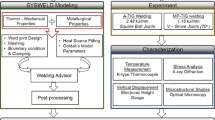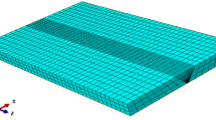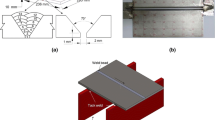Abstract
Localized heating and cooling during welding introduces residual stress in the weld joints due to the thermal gradients. The microstructure formation in 2.25Cr–1Mo steel is very much sensitive to the rate of cooling and eventually, the austenite may transform to pearlite/bainite/martensite. A variant of Tungsten Inert Gas (TIG) welding called Activated-TIG (A-TIG) welding was made use of in this study. Here, we have tried to develop a numerical model based on the finite element method to predict the thermo-mechanical behavior of 6 mm thick 2.25Cr–1Mo steel weld joints, with accounting solid-state phase transformation. The heat energy supplied to the workpiece is determined and calibrated in the heat source model. Simulated thermal cycle showed a peak temperature of 1377 °C at 8 mm distance away from the weld centerline, whereas, the experimental result showed 1371 °C. A k-type thermocouple was used to measure the temperature distribution during welding. The simulated thermal distributions were sequentially coupled to mechanical analysis. The evolution of stress and ultimately the locked-in residual stresses were determined. X-ray diffraction studies showed the peak residual stress near heat affected zone of 592 MPa and the vertical height gauge was used to measure the distortion before and after welding. The predicted residual stresses and distortion showed good agreement with the experimental measurements.
Access this chapter
Tax calculation will be finalised at checkout
Purchases are for personal use only
Similar content being viewed by others
References
Mochizuki, M.: Control of welding residual stress for ensuring integrity against fatigue and stress–corrosion cracking. Nucl. Eng. Des. 237(2), 107–123 (2007)
Vasantharaja, P., Maduarimuthu, V., Vasudevan, M., Palanichamy, P.: Assessment of residual stresses and distortion in stainless steel weld joints. Mater. Manuf. Processes 27(12), 1376–1381 (2012)
Na, H., Lee, S., Kang, C.: Effect of micro-segregation on impact toughness of 2.25 Cr-1Mo steel after post weld heat treatment. Metals 8(6), 373 (2018)
Trautwein, A., Mayer, H., Gysel, W., Walser, B.: Structure and mechanical properties of 2¼Cr-1Mo cast steel for pressure components with wall thicknesses up to 500 mm. In: Application of 2¼Cr-1 Mo Steel for Thick-Wall Pressure Vessels, ASTM International (1982)
Gojic, M., Kosec, L., Matkovic, P.: The effect of tempering temperature on mechanical properties and microstructure of low alloy Cr and CrMo steel. J. Mater. Sci. 33(2), 395–403 (1998)
Wada, T., Eldis, G.: Transformation characteristics of 2¼Cr-1Mo steel. In: Application of 2¼Cr-1 Mo Steel for Thick-Wall Pressure Vessels, ASTM International (1982)
Arivazhagan, B., Vasudevan, M.: Studies on A-TIG welding of 2.25 Cr-1Mo (P22) steel. J. Manuf. Processes 18, 55–59 (2015)
Mills, K., Keene, B., Brooks, R., Shirali, A.: Marangoni effects in welding. Philos. Trans. R. Soc. Lond., Ser. A Math. Phys. Eng. Sci. 911–926 (1998)
Friedman, E.: Thermomechanical analysis of the welding process using the finite element method. J. Pressure Vessel Technol. 97(3), 206–213 (1975)
Lindgren, L.-E.: Numerical modelling of welding. Comput. Methods Appl. Mech. Eng. 195(48–49), 6710–6736 (2006)
Hyde, T., Yaghi, A., Tanner, D., Bennett, C., Becker, A., Williams, E., Sun, W.: Current capabilities of the thermo-mechanical modelling of welding processes. J. Multiscale Model. 1, 451–478 (2009)
Deshpande, A., Xu, L., Sun, W., McCartney, D., Hyde, T.: Finite-element-based parametric study on welding-induced distortion of TIG-welded stainless steel 304 sheets. J. Strain Anal. Eng. Des. 46(4), 267–279 (2011)
Lindgren, L.-E.: Computational Welding Mechanics. Elsevier (2014)
Leblond, J., Devaux, J.: A new kinetic model for anisothermal metallurgical transformations in steels including effect of austenite grain size. Acta Metall. 32(1), 137–146 (1984)
Heinze, C., Pittner, A., Rethmeier, M., Babu, S.: Dependency of martensite start temperature on prior austenite grain size and its influence on welding-induced residual stresses. Comput. Mater. Sci. 69, 251–260 (2013)
Deng, D., Murakawa, H.: Finite element analysis of temperature field, microstructure and residual stress in multi-pass butt-welded 2.25 Cr–1Mo steel pipes. Comput. Mater. Sci. 43(4), 681–695 (2008)
Vakili-Tahami, F., Daei-Sorkhabi, A., Saeimi-S, M., Homayounfar, A.: 3D finite element analysis of the residual stresses in butt-welded plates with modeling of the electrode-movement. J. Zhejiang Univ. Sci. A 10(1), 37–43 (2009)
Deng, D., Tong, Y., Ma, N., Murakawa, H.: Prediction of the residual welding stress in 2.25 Cr-1Mo steel by taking into account the effect of the solid-state phase transformations. Acta Metall. Sin. (English Letters) 26(3), 333–339 (2013)
Goldak, J., Chakravarti, A., Bibby, M.: A new finite element model for welding heat sources. Metall. Trans. B 15(2), 299–305 (1984)
Author information
Authors and Affiliations
Corresponding author
Editor information
Editors and Affiliations
Rights and permissions
Copyright information
© 2019 Springer Nature Singapore Pte Ltd.
About this paper
Cite this paper
Pavan, A.R., Arivazhagan, B., Arun Kumar, S., Vasudevan, M., Mahadevan, S. (2019). Numerical Simulation and Experimental Validation of A-TIG Welding of 2.25Cr–1Mo Steel. In: Narayanan, R., Joshi, S., Dixit, U. (eds) Advances in Computational Methods in Manufacturing. Lecture Notes on Multidisciplinary Industrial Engineering. Springer, Singapore. https://doi.org/10.1007/978-981-32-9072-3_21
Download citation
DOI: https://doi.org/10.1007/978-981-32-9072-3_21
Published:
Publisher Name: Springer, Singapore
Print ISBN: 978-981-32-9071-6
Online ISBN: 978-981-32-9072-3
eBook Packages: Chemistry and Materials ScienceChemistry and Material Science (R0)




